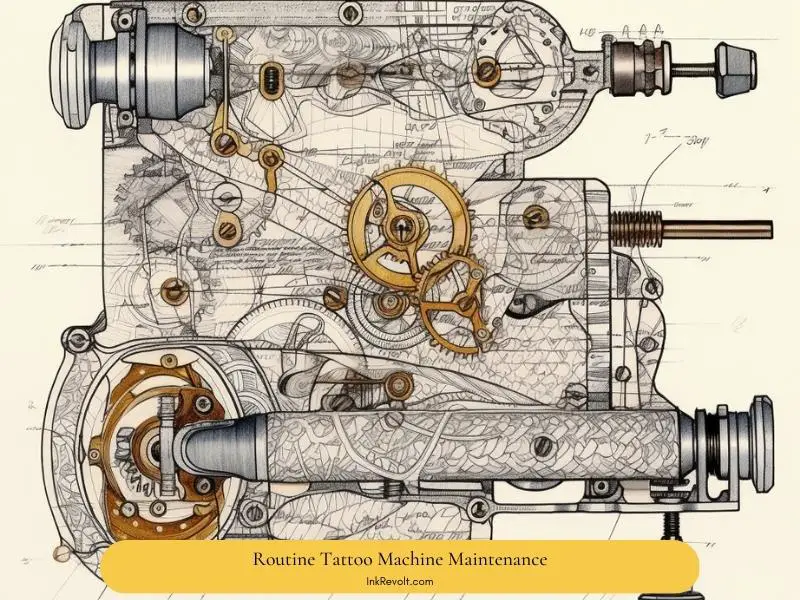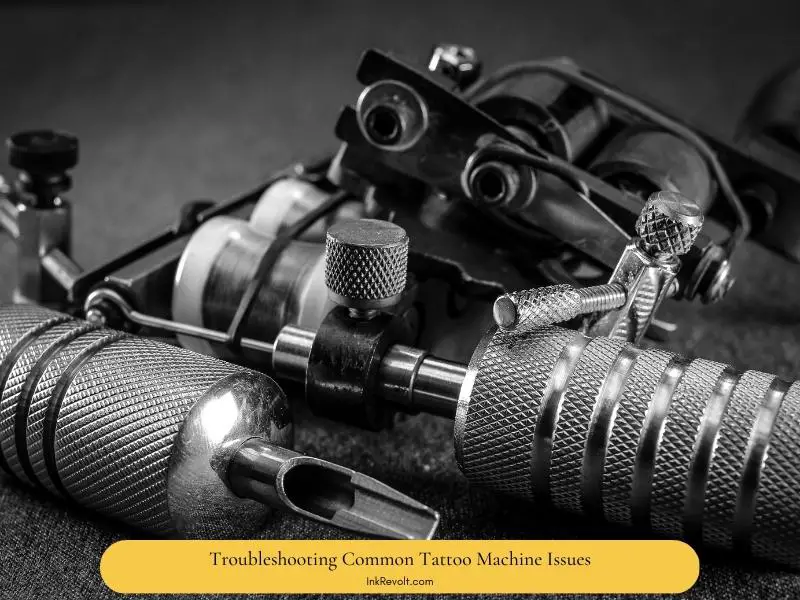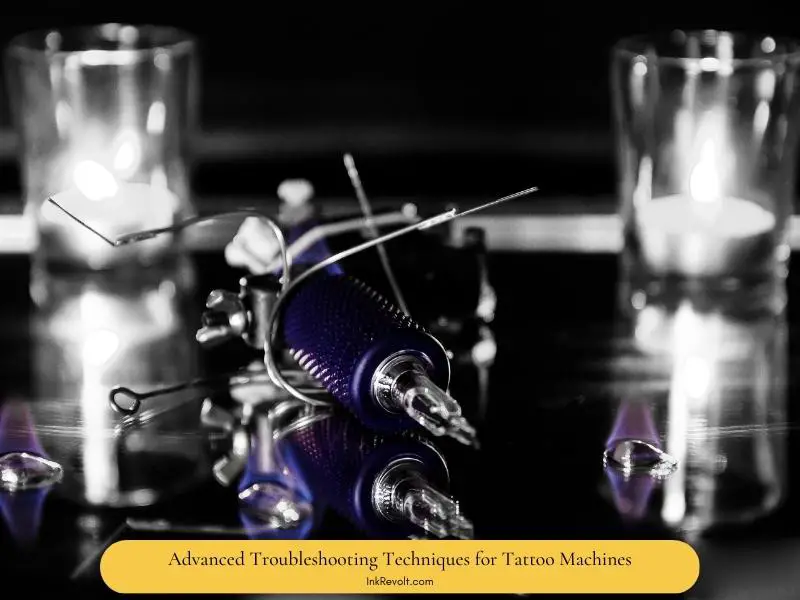Expert Secrets: Tattoo Machine Maintenance and Troubleshooting for Pros
Tattoo machines are intricate pieces of equipment that require regular care and attention to maintain their performance and longevity. In this guide, we will explore the different components of tattoo machines, essential maintenance tools and equipment, and how to perform routine maintenance and troubleshooting. Packed with valuable insights and expert tips, this guide is an indispensable resource for both novice and seasoned tattoo artists alike.
Tattoo Machine Components and Functions
Tattoo machines come in several types, with the most popular being coil, rotary, and pneumatic machines. Understanding the components and functions of each type is crucial to effective maintenance and troubleshooting.
Coil Tattoo Machines

Coil machines are the most common type of tattoo machines and operate using electromagnetic principles. Key components of coil machines include:
- Frame: The frame provides the structural foundation for the machine and houses all other components. Materials used for frames may vary, with brass, iron, and aluminum being common choices.
- Coils: Typically, a pair of copper wire-wrapped coils work in conjunction with the machine’s capacitor to create an electromagnetic field that drives the armature bar.
- Armature Bar: The armature bar is connected to the needle bar, and its movement controls the needle’s action. The armature bar moves up and down in response to the electromagnetic field generated by the coils.
- Contact Screw: The contact screw regulates the machine’s speed and needle depth. Adjusting the contact screw changes the gap between the front spring and the contact screw, altering the machine’s performance.
- Capacitor: The capacitor stores electrical energy and helps stabilize the machine’s voltage, preventing fluctuations that could negatively impact performance.
- Springs: Coil machines utilize two springs – front and rear – that control the armature bar’s movement and influence the machine’s speed and force.
Rotary Tattoo Machines
Rotary machines operate using a motor-driven mechanism to control needle movement. These machines are known for their smooth and quiet operation. Key components of rotary machines include:
- Motor: The motor is the heart of a rotary tattoo machine, converting electrical energy into mechanical energy to drive the needle.
- Cam: The cam is a rotating component connected to the motor’s output shaft. As the cam rotates, it translates the motor’s rotational motion into linear motion, controlling the needle’s movement.
- Needle Drive: The needle drive connects the cam to the needle bar, transferring the motion created by the cam to the needle.
Pneumatic Tattoo Machines
Pneumatic machines, though less common, use compressed air to drive the needle’s motion. These machines are lightweight and easy to clean, making them popular choices for some artists.
Comparison of Different Types of Tattoo Machines
| Tattoo Machine Type | Key Components | Advantages | Disadvantages |
|---|---|---|---|
| Coil | Frame, coils, armature bar, contact screw, capacitor, springs | Versatile, wide range of settings | Heavier, more maintenance required |
| Rotary | Motor, cam, needle drive | Smooth, quiet operation | Less customizable |
| Pneumatic | Air compressor, air-driven piston | Lightweight, easy to clean | Less common, may require more frequent compressor maintenance |
Essential Tattoo Machine Maintenance Tools and Equipment
Proper maintenance of your tattoo machine requires an assortment of tools and equipment. Here are some essentials:
- Screwdrivers: A set of various-sized screwdrivers will be necessary for adjusting and securing components like the contact screw and springs.
- Allen wrenches: Allen wrenches, also known as hex keys, are required for loosening and tightening the screws on certain machine components, such as the needle drive and frame.
- Needle-nose pliers: These pliers are useful for gripping small parts, bending springs, and adjusting components that may be difficult to reach with other tools.
- Multimeter: A multimeter is an essential diagnostic tool for measuring voltage, current, and resistance. It helps identify electrical issues within your tattoo machine.
- Lubricants: High-quality lubricants are necessary for keeping moving parts running smoothly and reducing friction, which can lead to wear and tear.
- Cleaning supplies: Regular cleaning of your tattoo machine is crucial to maintain proper hygiene and functionality. Supplies such as isopropyl alcohol, soft brushes, and lint-free cloths are essential for cleaning and disinfecting.
- Replacement parts: Having spare components, like springs, screws, and capacitors, on hand can save you time and ensure you’re prepared for any unexpected maintenance needs.
Routine Tattoo Machine Maintenance

Performing routine maintenance on your tattoo machine not only ensures its longevity but also keeps your work at its highest quality. Here’s a rundown of essential maintenance tasks and procedures:
1. Cleaning
Regular cleaning is crucial for maintaining a hygienic and well-functioning tattoo machine.
- Frequency: Ideally, you should clean your machine after each session. Thoroughly clean and disinfect your machine at least once a week or whenever you notice a buildup of ink, dirt, or debris.
- Proper cleaning techniques: To clean your machine, first, remove any loose components, like the needle and tube. Then, use a soft brush and isopropyl alcohol to gently scrub the machine’s surfaces. Be careful not to saturate the coils or other sensitive components with alcohol. Finally, use a lint-free cloth to dry and polish the machine.
- Disinfection and sterilization: Disinfecting your tattoo machine is necessary for maintaining a sterile work environment. Use a hospital-grade disinfectant to clean the machine’s surfaces, and consider using an autoclave for sterilizing components that come into contact with the skin, like tubes and grips.
2. Lubrication
Proper lubrication is vital for smooth operation and reducing wear on your machine’s moving parts.
- Lubricating moving parts: Apply a small amount of lubricant to the moving parts of your machine, such as the armature bar, cam, and needle drive. Be sure to lubricate any areas where friction occurs.
- Types of lubricants: Use high-quality lubricants specifically designed for tattoo machines or other precision instruments. Avoid using petroleum-based lubricants, as they can attract dirt and debris.
- Avoiding over-lubrication: Excessive lubrication can lead to a buildup of dirt and grime, which may impair your machine’s performance. Apply lubricant sparingly, and wipe away any excess with a lint-free cloth.
3. Checking and Tightening Screws
Loose screws can lead to machine instability and decreased performance. Regularly check the tightness of all screws on your tattoo machine, paying particular attention to the contact screw, armature bar, and frame.
4. Inspecting and Replacing Springs
Springs are critical components of coil tattoo machines, controlling the machine’s speed and force. Regularly inspect your springs for signs of wear or damage, and replace them when necessary.
5. Monitoring Capacitor Health
The capacitor is responsible for stabilizing your tattoo machine’s voltage. Monitor your capacitor for any signs of malfunction or degradation, and replace it if necessary.
6. Replacing Worn-Out Parts
Inspect your machine regularly for any worn or damaged components, such as needles, needle bars, and armature bars. Replace these parts as needed to ensure optimal
performance and maintain the quality of your work.
7. Maintaining Proper Voltage
Operating your tattoo machine at the correct voltage is crucial for optimal performance and preventing overheating. Regularly check your power supply to ensure it’s providing a stable and consistent voltage. Make any necessary adjustments to maintain the recommended voltage for your specific machine.
Troubleshooting Common Tattoo Machine Issues

Even with regular maintenance, tattoo machines may still encounter issues. Here’s a list of common problems and their potential solutions:
1. Inconsistent Power
Inconsistent power can lead to poor tattoo quality and machine performance. Possible causes include:
- Voltage fluctuations: Check your power supply to ensure it’s providing a consistent voltage. Adjust the voltage or replace the power supply if necessary.
- Poor power supply connections: Inspect the connections between your machine and the power supply. Ensure all connections are secure and free from corrosion or damage.
- Damaged power cords: Check your power cords for any signs of wear, fraying, or damage. Replace damaged cords to prevent potential electrical hazards and maintain consistent power.
2. Erratic Needle Movement
Erratic needle movement can cause inconsistent line work and shading. Some possible causes are:
- Loose or damaged needle bar: Check the needle bar for any signs of damage or looseness. Replace the needle bar if necessary and ensure it’s securely attached to the armature bar.
- Bent or misaligned needles: Inspect your needles for any signs of bending or misalignment. Replace any damaged needles and ensure they’re properly installed.
- Worn-out or damaged cam: In rotary machines, a worn or damaged cam can cause erratic needle movement. Inspect the cam for wear and replace it if necessary.
3. Overheating
Overheating can damage your tattoo machine and decrease its lifespan. Possible causes include:
- Excessive voltage: Operating your machine at a voltage that’s too high can cause overheating. Check your power supply and adjust the voltage to the recommended level for your specific machine.
- Insufficient lubrication: Friction between moving parts can generate heat and cause overheating. Ensure all moving components are adequately lubricated to reduce friction and prevent overheating.
- Friction between components: Inspect your machine for any components that may be rubbing against each other, causing friction and heat. Adjust or replace any parts as necessary to eliminate friction.
4. Unusual Noise
Unusual noise coming from your tattoo machine can indicate a problem with its components. Some potential causes are:
- Loose screws or components: Inspect your machine for any loose screws or parts. Tighten any loose connections to reduce noise and improve performance.
- Misaligned armature bar: If the armature bar is misaligned, it may cause noise and impact the machine’s performance. Check the alignment and adjust it as needed.
- Damaged springs: In coil machines, damaged or improperly installed springs can cause noise. Inspect the springs for damage and replace them if necessary.
5. Electrical Issues
Electrical problems can lead to erratic machine performance and potential hazards. Some possible causes are:
- Faulty wiring: Inspect your machine’s wiring for any signs of damage or wear. Replace any damaged wiring to prevent short circuits and electrical hazards.
- Short circuits: A short circuit can cause your machine to malfunction and pose a risk to your safety. Use a multimeter to diagnose potential short circuits and address any issues immediately.
- Malfunctioning capacitor: A faulty capacitor can lead to unstable voltage and poor machine performance. Monitor your capacitor’s health and replace it if necessary.
Preventative Measures to Extend Tattoo Machine Lifespan

Taking a proactive approach to your tattoo machine’s maintenance can extend its lifespan and prevent potential issues before they arise. Consider the following preventative measures:
- Regular inspections: Frequently examine your tattoo machine for any signs of wear, damage, or loose components. Addressing issues early can prevent more significant problems down the line.
- Proper storage: Store your tattoo machine in a clean, dry, and temperature-controlled environment when not in use. This can help prevent corrosion, damage, and the buildup of dirt and debris.
- Avoiding overuse: Overusing your tattoo machine can lead to overheating and increased wear on its components. Give your machine ample time to cool down between sessions and consider having a backup machine to help distribute the workload.
- Staying up-to-date with industry developments: Regularly research and stay informed about the latest advancements in tattoo machine technology and maintenance techniques. Adopting new knowledge and practices can help you better care for your machine and ensure it remains in optimal condition.
- Investing in high-quality equipment: Higher-quality tattoo machines and components often have better durability and performance. Investing in well-made equipment can save you time, money, and frustration in the long run.
- Seeking professional assistance: If you’re unsure about a maintenance or troubleshooting issue, consult with an experienced tattoo artist or technician. They can provide valuable insights and guidance to help you properly care for your tattoo machine.
Advanced Troubleshooting Techniques for Tattoo Machines

While routine maintenance and basic troubleshooting can address many common issues, some problems may require more advanced techniques. In this section, we will explore advanced troubleshooting methods for experienced tattoo artists or those seeking to expand their skill set.
1. Diagnosing Motor Issues in Rotary Machines
Rotary machines rely on a motor to drive the needle’s movement. If you suspect a motor issue, follow these steps:
- Check for power: Ensure the motor is receiving power by testing the voltage at the motor’s terminals using a multimeter. If there is no voltage, inspect the wiring and connections.
- Inspect the brushes: The brushes inside the motor can wear out over time. Check for signs of wear or damage and replace them if necessary.
- Test the motor’s resistance: Use a multimeter to measure the motor’s resistance. High resistance may indicate damaged windings or short circuits within the motor.
- Seek professional assistance: If you’re unable to identify or resolve the motor issue, consult a professional technician or consider replacing the motor.
2. Adjusting Spring Tension in Coil Machines
The tension of the springs in a coil machine can impact its performance. Here’s how to adjust spring tension:
- Inspect the springs: Check the springs for signs of wear, damage, or improper installation. Replace any damaged springs and ensure they’re correctly installed.
- Adjust the contact screw: Turning the contact screw clockwise increases spring tension, while turning it counterclockwise decreases tension. Make small adjustments and test the machine’s performance after each adjustment.
- Bend the springs: If necessary, use needle-nose pliers to carefully bend the springs to adjust their tension. Be cautious not to over-bend the springs, as this can cause damage or negatively impact performance.
3. Calibrating Pneumatic Machines
Pneumatic machines require proper calibration to ensure optimal performance. Here’s how to calibrate a pneumatic machine:
- Inspect the air compressor: Ensure the air compressor is functioning correctly and providing consistent air pressure. Check for any leaks, damage, or malfunctions, and address them as needed.
- Adjust the air pressure: Use the air pressure regulator to set the appropriate pressure for your specific machine. Consult the manufacturer’s guidelines for recommended pressure settings.
- Inspect the air-driven piston: Check the piston for signs of wear or damage and ensure it’s properly lubricated. Replace any damaged components and ensure the piston moves smoothly.
- Test the machine: After making adjustments, test your pneumatic machine to ensure it’s operating at peak performance. If necessary, make additional adjustments to achieve optimal performance.
Conclusion
A well-maintained tattoo machine is essential for producing high-quality work and ensuring the satisfaction of your clients. This comprehensive guide to tattoo machine maintenance and troubleshooting covers everything you need to know to keep your equipment in top condition, from routine maintenance tasks to advanced troubleshooting techniques.
By staying informed, diligent, and proactive in your machine’s care, you can ensure it remains in optimal condition, allowing you to focus on your artistry and building a successful career as a tattoo artist. Remember, investing time and effort in proper tattoo machine maintenance will pay off in the long run by protecting your equipment and maintaining the quality of your work.
